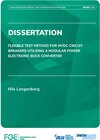Flexible Test Method for MVDC Circuit Breakers Utilizing a Modular Power Electronic Buck Converter
von Nils LangenbergMVDC Circuit Breaker (CB) technology is one of the key enablers for the sustained penetration of meshed MVDC grids. In such grids, the fault current characteristics differ fundamentally from those in AC grids. This is expressed in particular by the lack of natural current zero crossings, a high initial current steepness and a quasi-stationary peak fault current of several kA after only a few ms. These characteristics render conventional AC CB practically inapplicable for MVDC grids. The same applies accordingly to the use of classic AC CB test circuits for the development and investigation of MVDC CBs.
Therefore, a fl exible high-power test method for MVDC CBs is developed in this thesis. By utilizing the functionality of a Power Electronic Buck Converter (PEBC), the reproduction of realistic stresses during a DC fault current interruption is enabled. The underlying necessary test current and test voltage ratings require a modularization into individual PEBC modules that are interconnected in series and parallel to reach the derived ratings. In this regard, the interconnection of the individual PEBC modules, to form one overall high-power test circuit, is of particular interest. The corresponding investigations show a sensitivity of the test circuit control stability already on minor deviations in the connection and stray inductances between individual modules. Within the course of this thesis, interconnection designs are developed that enable a stable and effi cient test circuit operation. On the basis of these investigations and underlined with conducted experiments regarding the generation of DC fault current envelope curves, design criteria for future applications are derived. The overall validity of the developed test method is fi nally demonstrated by an exemplary current interruption.
In conclusion, the fl exible test method utilizing a modular PEBC for the investigation of MVDC CBs is available and can be flexibly adapted to future requirements due to the developed modularity.
Therefore, a fl exible high-power test method for MVDC CBs is developed in this thesis. By utilizing the functionality of a Power Electronic Buck Converter (PEBC), the reproduction of realistic stresses during a DC fault current interruption is enabled. The underlying necessary test current and test voltage ratings require a modularization into individual PEBC modules that are interconnected in series and parallel to reach the derived ratings. In this regard, the interconnection of the individual PEBC modules, to form one overall high-power test circuit, is of particular interest. The corresponding investigations show a sensitivity of the test circuit control stability already on minor deviations in the connection and stray inductances between individual modules. Within the course of this thesis, interconnection designs are developed that enable a stable and effi cient test circuit operation. On the basis of these investigations and underlined with conducted experiments regarding the generation of DC fault current envelope curves, design criteria for future applications are derived. The overall validity of the developed test method is fi nally demonstrated by an exemplary current interruption.
In conclusion, the fl exible test method utilizing a modular PEBC for the investigation of MVDC CBs is available and can be flexibly adapted to future requirements due to the developed modularity.






